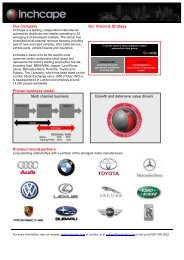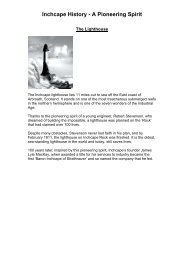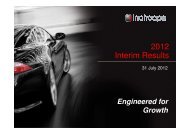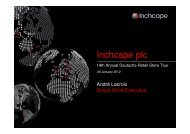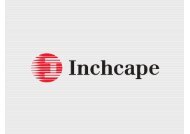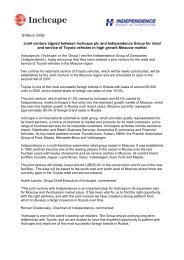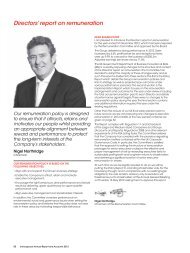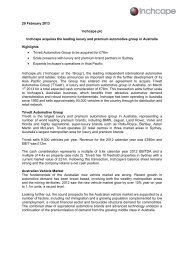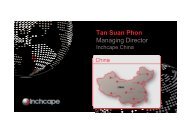Full Annual Report - Inchcape
Full Annual Report - Inchcape
Full Annual Report - Inchcape
Create successful ePaper yourself
Turn your PDF publications into a flip-book with our unique Google optimized e-Paper software.
Business review<br />
Strategy<br />
Corporate responsibility continued<br />
Our environment<br />
In 2008,the Group commenced collecting data on its CO 2 footprint,measured<br />
against three core Key Performance Indicators (KPIs).<br />
Energy<br />
Transport<br />
Flights<br />
This KPI measures our global electricity and gas usage.<br />
For the last six months of 2008,and during 2009 data has been<br />
collated on the basis of megawatt hours for electricity and<br />
cubic metres for gas.<br />
This KPI measures the movement of cars and parts from<br />
the point of ownership (which means legal or contractual<br />
ownership) to the point we cease to have legal ownership.<br />
This includes test drives.We calculate our CO 2 footprint by<br />
car or parts kilometres depending on the mode of transport<br />
with a CO 2 multiplier.<br />
This KPI measures the impact of the movement of our people.<br />
We have recorded the number of flights (each flight leg counts<br />
as one unit) and calculated our flight CO 2 emissions with a<br />
multiplier by flight kilometre.<br />
In January 2009, following an internal<br />
review of the data collected and the<br />
collection process, it was agreed that the<br />
processes should be refined to maximise<br />
their robustness and enable independent<br />
verification, as appropriate.<br />
Since that review, we have continued<br />
to collect data from our markets against<br />
all three core KPIs.This data has begun<br />
to provide us with insights into our CO 2<br />
footprint. However, we consider that<br />
additional data collection is required in<br />
order to provide meaningful guidance.<br />
Namely:<br />
• additional CO 2 data is required in order<br />
to understand if seasonality has an<br />
impact on our data usage;<br />
• whilst there are early indications of trend<br />
patterns in the data, there is insufficient<br />
data to establish if these are actual or<br />
perceived trends;<br />
• verification of the robustness of our data.<br />
We are ensuring that from the start of the<br />
process we are building in sufficient<br />
control points so that our data is<br />
capable of independent verification as<br />
part of our overall planning process for<br />
this element of our CR programme.<br />
Early conclusions that can be<br />
drawn are:<br />
By recycling rainwater, using ground source heating pumps and solar power to heat<br />
water, <strong>Inchcape</strong> Honda in Romford, UK uses around 30% less energy than a standard<br />
car showroom.<br />
Analysing our CO 2 footprint is providing us<br />
with data from which we can evaluate how<br />
we can manage emissions and reduce<br />
costs in the supply chain. For example,<br />
in some markets we rely on air freight to<br />
support our business, particularly around<br />
the import of critical supplies which can be<br />
dependent on aftersales requirements.We<br />
will use the data to analyse if changes are<br />
appropriate to support our business<br />
requirements, reduce our CO 2 footprint<br />
and reduce costs, thereby benefiting our<br />
customers and our stakeholders alike.<br />
Additionally, measuring our direct<br />
costs using a CO 2 metric will present<br />
opportunities to work closely with our<br />
brand partners as we can support their<br />
CR values and vice versa, ensuring that<br />
there is a consistent approach throughout<br />
all elements of the supply chain.<br />
48<br />
<strong>Inchcape</strong> plc ¦ <strong>Annual</strong> <strong>Report</strong> and Accounts 2009






